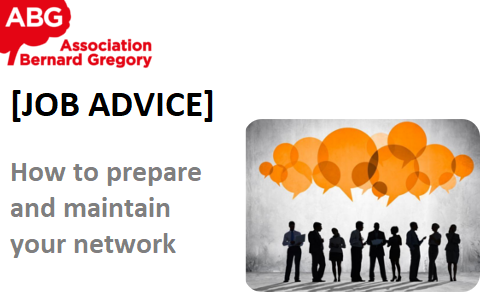Networking is a powerful career booster. And one of the places to put it into practice for optimum outcomes is during networking events.
Here are a few tips on how to optimize your network approach before and after these events.
You have the opportunity to meet with professionals and develop your network at a networking event or ApéroDoc.
To help you make the most of it, ABG offers a series of tips for optimizing your networking process before, during and after the event. Feel free to use them as checklists:
- Research participants' (speakers') profiles and backgrounds
Using the program of the event, consider reviewing the profiles and backgrounds of the speakers. Greater knowledge of their backgrounds, experiences and activities will allow you to be relevant to your approach and questions. To do so, diversify your search channels: websites, blogs and social networks (including LinkedIn)!
- Get your business cards ready (for a face-to-face meeting)
They are essential because they leave a material record of your encounter with those who will integrate your network. They should include at least: your first and last name, address, telephone number and email address.
- Are you unemployed? Prior to giving out a business card, we recommend that you note down the purpose of your exchange by hand;
- Your employer didn't make you one? Take the initiative [there are plenty of creative and print solutions online, all for a small fee. Count on an average of 5-10 € + delivery for 250 printed cards on one side]
N.B.: Any use of your employer's logo must be authorised by your employer.
For an online event, be sure to check your connection, if your computer is equipped with a camera and microphone so that others can see and hear you, and remember you. To be identified quickly, use your first name, last name, or even email address. Keep your camera on for the duration of the event if the format requires it. It is more likely to keep in touch with people who have seen your face, even through a screen.
- Get your pitch ready
A networking interview can be decisive in a PhD holder's career, especially if it is tailored to your professional plans. Its success lies in two aspects:
- The components presented (career path and goals);
- Concise presentation. Keep in mind that your time is limited and should not exceed two minutes and that you should be able to quickly give the floor to the person you are meeting.
For a smooth, efficient pitch, we recommend that you read an article “Hands-on guide on how to pitch for a networking interview”
-
Proper attire required
To attend a business event, a business dress code is required. Indeed, even if "clothes don't make a man", it is no less true that proper attire gives you credibility as a professional in the eyes of your interlocutors and is a mark of respect towards them (It is also true for online events).
- Reciprocity
Expanding your network means first and foremost being part of a community where you can ask for help as well as for help. So be ready to provide help too.
- Stay attentive
It is not because you are the instigator of the exchange that you monopolize the floor. Keep in mind that the exchange, although motivated by your objective, should give your interlocutor the opportunity to speak, to question you.
- Afterwards, have a LinkedIn reflex
A good network is an ongoing process. After a meeting full of interesting exchanges, boost the effectiveness of your approach by adding your contact on LinkedIn. As a courtesy, you must accompany your request with a personal note reminding you of the context in which you met. You're restricted to 300 characters, so again, be concise.
- Maintain your network over time
Once connected, you must keep your network alive. Here are a few pieces of advice:
- All occasions are good opportunities to request news from your contacts (greetings, professional anniversaries, congratulations...). Use LinkedIn's notification system,
- Create and/or share relevant content for you AND them. Share quality resources. Relay the information which interests them... They will return the favour to you,
- Call on your network. An example: when you are looking for a job, your network can provide you with a pool of resources to help you find information on a job, a company, or more challenging issues such as the level of salary offered by one particular company or the corporate culture in another.

